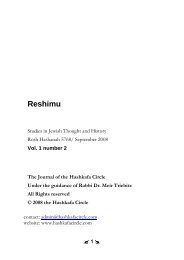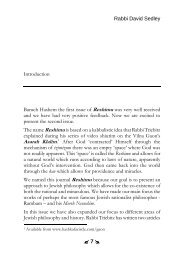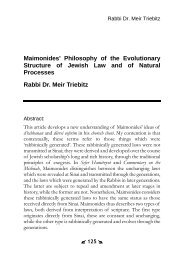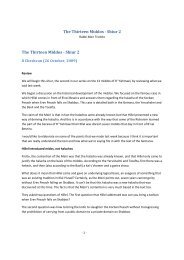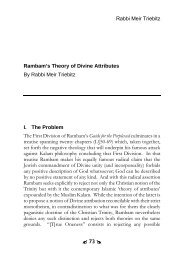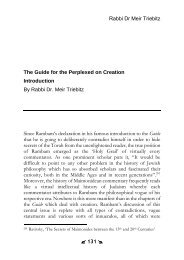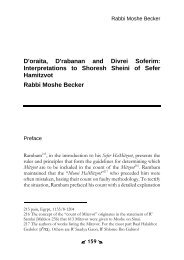The Timeless Message of Moreh Nevuchim - Hashkafa Circle
The Timeless Message of Moreh Nevuchim - Hashkafa Circle
The Timeless Message of Moreh Nevuchim - Hashkafa Circle
Create successful ePaper yourself
Turn your PDF publications into a flip-book with our unique Google optimized e-Paper software.
Rabbi Moshe Becker<br />
<strong>The</strong> <strong>Timeless</strong> <strong>Message</strong> <strong>of</strong> <strong>Moreh</strong> <strong>Nevuchim</strong><br />
By Rabbi Moshe Becker<br />
Contemporary study <strong>of</strong> <strong>Moreh</strong> <strong>Nevuchim</strong> has become almost<br />
exclusively the occupation <strong>of</strong> academics and students <strong>of</strong> medieval<br />
philosophy. Little, if any, serious attention is given to Rambam’s great<br />
philosophical treatise in many Yeshivas. This is perhaps too broad a<br />
generalization, and certainly the issues are more complex, yet such a<br />
trend can be discerned. <strong>The</strong> following essay will suggest that, in<br />
contrast to the attitude mentioned, <strong>Moreh</strong> <strong>Nevuchim</strong> can in fact be a<br />
relevant text and source <strong>of</strong> inspiration to a Torah student even today.<br />
I will be using Rambam’s treatment <strong>of</strong> the creation as our model.<br />
This is not to imply that study <strong>of</strong> <strong>Moreh</strong> <strong>Nevuchim</strong> in the context <strong>of</strong><br />
medieval Jewish philosophy alone is not a worthwhile pursuit. My<br />
intention here is to present what I believe to be the overall purpose<br />
<strong>of</strong> <strong>Moreh</strong> <strong>Nevuchim</strong> and its primary content, and thereby address some<br />
objections that could be raised against studying <strong>Moreh</strong> <strong>Nevuchim</strong> as a<br />
relevant text or as a fulfillment <strong>of</strong> Talmud Torah.<br />
To clarify the context <strong>of</strong> the discussion, I will begin with an overview<br />
<strong>of</strong> the main schools <strong>of</strong> thought regarding the purpose and content <strong>of</strong><br />
<strong>Moreh</strong> <strong>Nevuchim</strong> and some <strong>of</strong> the difficulties associated with them.<br />
33
<strong>The</strong> <strong>Timeless</strong> <strong>Message</strong> <strong>of</strong> <strong>Moreh</strong> <strong>Nevuchim</strong><br />
<strong>The</strong> natural place to expect to find the purpose <strong>of</strong> a book is in the<br />
author’s introduction. Yet, Rambam’s description <strong>of</strong> the content <strong>of</strong><br />
<strong>Moreh</strong> <strong>Nevuchim</strong> appears to fall short <strong>of</strong> actually providing this<br />
information. A simple reading <strong>of</strong> the Introduction to <strong>Moreh</strong> <strong>Nevuchim</strong><br />
reveals two purposes the author attributed to the book. <strong>The</strong> first is to<br />
explain certain terms and phrases found in the Torah which appear to<br />
be incompatible with an all-encompassing rational understanding <strong>of</strong><br />
the world. Here Rambam describes his reader as an individual who is<br />
committed to Torah, perfected his person, and has studied the<br />
natural sciences and philosophy. This person has come to appreciate<br />
the place <strong>of</strong> the intellect, and feels that a rational position at times<br />
conflicts with a simple reading <strong>of</strong> the Torah, such as where<br />
anthropomorphic references to G-d are found. <strong>The</strong> second objective<br />
<strong>of</strong> <strong>Moreh</strong> <strong>Nevuchim</strong>, writes Rambam, is to identify, and at times<br />
explain, sections <strong>of</strong> the Torah that are to be understood allegorically.<br />
Chief among these are the doctrines <strong>of</strong> Ma’ase Bereishis – the story<br />
<strong>of</strong> creation, and Ma’ase Merkava – the description <strong>of</strong> “G-d’s chariot”<br />
as described by Yechezkel. Rambam says that these esoteric<br />
doctrines, along with several others, were intended to be understood<br />
figuratively, and Rambam wished to explain as much <strong>of</strong> their message<br />
as possible. 29<br />
However one wishes to broaden the meaning <strong>of</strong> these statements in<br />
the Introduction, it is clear that <strong>Moreh</strong> <strong>Nevuchim</strong> goes well beyond<br />
exegesis, even <strong>of</strong> the complex matters referred to. Lengthy<br />
argumentation detailing the precise logical foundations for proving<br />
G-d’s existence 30 ; attacks against pro<strong>of</strong>s that Rambam felt were<br />
incorrect 31 ; a lengthy discourse on G-d’s incorporeality and<br />
29 <strong>Moreh</strong> <strong>Nevuchim</strong>, Introduction. See also H. Davidson, Moses Maimonides,<br />
[New York: Oxford University Press, 2005] pp. 327-329.<br />
30 Beginning <strong>of</strong> Section 2 <strong>of</strong> <strong>Moreh</strong> <strong>Nevuchim</strong>.<br />
31 <strong>Moreh</strong> <strong>Nevuchim</strong>, Section 2, Chapter 8, 19.<br />
34
Rabbi Moshe Becker<br />
attributes 32 , and a detailed analysis <strong>of</strong> the philosophical underpinnings<br />
<strong>of</strong> the creation versus eternity question 33 are but some <strong>of</strong> the areas<br />
where Rambam extends himself far beyond instruction in an<br />
intellectually satisfying and rational reading <strong>of</strong> the Torah. At the same<br />
time, it is hardly fair to ignore the words <strong>of</strong> an author describing his<br />
book and its purpose, and I believe that my essay will also serve to<br />
address this difficulty 34 .<br />
To all appearances, <strong>Moreh</strong> <strong>Nevuchim</strong> seems to be a philosophical work,<br />
addressing all or most <strong>of</strong> the issues facing philosophers in the middle<br />
ages. Rambam brings the opinions <strong>of</strong> the different philosophers on<br />
these issues and argues for those which he felt were correct, usually<br />
favoring Aristotle’s positions. In general, Aristotle’s opinions are the<br />
logical framework for much <strong>of</strong> Rambam’s discussion, and one need<br />
not be full versed in Rambam’s works to realize that he held Aristotle<br />
in very high esteem. 35<br />
Most medieval readers <strong>of</strong> <strong>Moreh</strong> <strong>Nevuchim</strong> viewed the work as a<br />
reckoning between the Torah and Aristotelian science 36 . Rambam<br />
does not only align the Torah with Aristotelian thought as much as<br />
possible; a general characteristic <strong>of</strong> <strong>Moreh</strong> <strong>Nevuchim</strong> is the attempt to<br />
rationalize more oblique elements <strong>of</strong> the Torah and place them in a<br />
more understandable conceptual framework 37 .<br />
This reading <strong>of</strong> <strong>Moreh</strong> <strong>Nevuchim</strong> led to two types <strong>of</strong> reactions. Readers<br />
who were philosophically oriented and viewed Aristotelian science as<br />
32 <strong>Moreh</strong> <strong>Nevuchim</strong>, Section 1, from Chapter 68.<br />
33 <strong>Moreh</strong> <strong>Nevuchim</strong>, Section 2, Chapter 13-30<br />
34 See H. Davidson, Moses Maimonides, [New York: Oxford University Press,<br />
2005] p. 332-333<br />
35 See <strong>Moreh</strong> <strong>Nevuchim</strong> Section 1:92, Shemona Perakim, 8<br />
36 See J. Guttmann, <strong>The</strong> Philosophy <strong>of</strong> Judaism, [Northavale, NJ: Jason<br />
Aronson, 1988] from p. 183.<br />
37 As he does with his explanations <strong>of</strong> various Mitzvos, for example.<br />
35
<strong>The</strong> <strong>Timeless</strong> <strong>Message</strong> <strong>of</strong> <strong>Moreh</strong> <strong>Nevuchim</strong><br />
authoritative embraced <strong>Moreh</strong> <strong>Nevuchim</strong> as a synthesis between two<br />
important sources <strong>of</strong> truth - the Torah and philosophy. On the other<br />
hand, those who were not inclined to accepting philosophy as a<br />
viable source <strong>of</strong> truth felt that <strong>Moreh</strong> <strong>Nevuchim</strong> was quite dangerous.<br />
<strong>The</strong> enterprise <strong>of</strong> reconciling Torah and philosophy obviously carries<br />
with it an endorsement <strong>of</strong> something other than Torah as a source <strong>of</strong><br />
truth. This was at best a foreign, at worst a dangerous, idea<br />
threatening to undermine basic acceptance <strong>of</strong> Torah as the ultimate<br />
source <strong>of</strong> wisdom. 38<br />
<strong>The</strong> two opposing viewpoints, and the reactions to <strong>Moreh</strong> <strong>Nevuchim</strong><br />
that they engendered, evolved into an ongoing controversy.<br />
Beginning already in Rambam’s lifetime, the ensuing, centuries-long<br />
dispute led to much acrimony in the Jewish community. Early on<br />
already, <strong>Moreh</strong> <strong>Nevuchim</strong> was banned by some communities, eventually<br />
leading to Christian authorities publicly burning the book 39 .<br />
For their part, the individuals and communities who embraced <strong>Moreh</strong><br />
<strong>Nevuchim</strong> concentrated their efforts on interpretation and exploring<br />
precisely how Rambam went about resolving conflict between the<br />
Torah and philosophy. A large number <strong>of</strong> Torah scholars and<br />
philosophers wrote commentaries on <strong>Moreh</strong> <strong>Nevuchim</strong> with this goal,<br />
including those who translated the work from its original Arabic to<br />
Hebrew; every translation necessarily containing an element <strong>of</strong><br />
interpretation as well.<br />
To a certain degree, the prevailing attitude towards <strong>Moreh</strong> <strong>Nevuchim</strong> in<br />
the Jewish community today, which I described at the beginning <strong>of</strong><br />
this essay, is really a modern, perhaps more passive form <strong>of</strong> the same<br />
38 See J. Guttmann, <strong>The</strong> Philosophy <strong>of</strong> Judaism, [Northavale, NJ: Jason<br />
Aronson, 1988] p. 184, and n. 11.<br />
39 See I. Dobbs-Weinstein, “<strong>The</strong> Maimonidean Controversy” in History <strong>of</strong><br />
Jewish Philosophy, [London: Routledge, 1997] from p. 331, and Y. Dan "<br />
" , Tarbiz 35 (1965) from p. 295.<br />
36 <br />
הפולמוס<br />
על כתבי הרמב"ם
Rabbi Moshe Becker<br />
conflict. Some <strong>of</strong> the greatest opponents to <strong>Moreh</strong> <strong>Nevuchim</strong> and study<br />
<strong>of</strong> philosophy in general were the great leaders <strong>of</strong> their generation,<br />
and respected as towering figures in Torah and Halachic ruling. For<br />
this reason, their position regarding <strong>Moreh</strong> <strong>Nevuchim</strong> was accepted by<br />
many - if not outright at the very least by default: as teachers, they<br />
were the ones setting the patterns <strong>of</strong> study for students, ultimately<br />
affecting the entire constituency. Study <strong>of</strong> philosophy, which had<br />
actually been formally banned for younger students 40 , came to be<br />
regarded as a less than legitimate occupation and <strong>Moreh</strong> <strong>Nevuchim</strong><br />
remained an object <strong>of</strong> some suspicion. Eventually this approach<br />
pervaded a good deal <strong>of</strong> the Jewish community, adumbrating the<br />
current situation in many Yeshivas, where <strong>Moreh</strong> <strong>Nevuchim</strong> is largely<br />
ignored. Among those who do study <strong>Moreh</strong> <strong>Nevuchim</strong>, the approach<br />
has remained similar to that <strong>of</strong> the medieval readers, and <strong>Moreh</strong><br />
<strong>Nevuchim</strong> is seen as some type <strong>of</strong> reckoning between the Torah and<br />
the Aristotelian science which Rambam adopted. Once again, to a<br />
strict traditionalist the suggestion that Aristotelian science is<br />
something to be reckoned with is itself a problematic position. <strong>The</strong>re<br />
is however, one major difference between then and now. In the<br />
middle ages much more was at stake, as Aristotle’s description <strong>of</strong> the<br />
natural world was largely accepted as true. In our times, it is<br />
rationalism itself that has come to be looked upon as incompatible<br />
with Torah, while Aristotelian science can hardly be viewed as a<br />
serious threat. I believe that this difference leaves more room for the<br />
approach I am going to suggest.<br />
<strong>The</strong> difficulties with understanding <strong>Moreh</strong> <strong>Nevuchim</strong> as an attempted<br />
reconciliation between the Torah and Aristotle go beyond the<br />
“religious” issue <strong>of</strong> Rambam having accepted foreign sources <strong>of</strong><br />
truth. In the first place, if it is true that Rambam’s goal was to present<br />
a rendering <strong>of</strong> Torah compatible with Aristotle’s philosophy, he<br />
failed to do so. Aside from the very obvious point <strong>of</strong> creation ex<br />
40 She’elot U’teshuvot HaRashba Responsa 415<br />
37
<strong>The</strong> <strong>Timeless</strong> <strong>Message</strong> <strong>of</strong> <strong>Moreh</strong> <strong>Nevuchim</strong><br />
nihilo, where Rambam openly rejects Aristotle’s position, the basic<br />
ideas <strong>of</strong> providence and reward and punishment are not reconciled<br />
with Aristotle. Furthermore, the idea <strong>of</strong> a G-d given Torah is hardly a<br />
concept that fits in with Aristotle’s conception <strong>of</strong> G-d’s role in the<br />
world. Aristotle’s view <strong>of</strong> natural law is purely deterministic, and G-d,<br />
although causally prior to the universe, cannot in fact change<br />
anything about the world. As Rambam himself points out, this<br />
position is entirely at odds with the concept <strong>of</strong> G-d giving the Torah<br />
to a chosen people 41 .<br />
Different authors sought to resolve these difficulties in various ways,<br />
some <strong>of</strong> their conclusions highly original. On the one hand the most<br />
extreme “harmonists” truly believed that Rambam was teaching a<br />
doctrine that interpreted the Torah as Aristotelian philosophy.<br />
Faithful to this understanding, they wrote commentaries explaining<br />
and clarifying <strong>Moreh</strong> <strong>Nevuchim</strong> and revealing the “secrets” <strong>of</strong> the<br />
collusion <strong>of</strong> Torah and Aristotelian science. <strong>The</strong>y had no<br />
compunctions about doing this and stated clearly that where there<br />
appears to be an ambiguity in <strong>Moreh</strong> <strong>Nevuchim</strong>, the passage should be<br />
interpreted so as to agree with Aristotle. In their own original works<br />
as well, the attempt at achieving an interpretation <strong>of</strong> the Torah in<br />
accordance with Aristotelian science can be seen.<br />
At this point, the idea <strong>of</strong> an esoteric message in <strong>Moreh</strong> <strong>Nevuchim</strong><br />
formed. <strong>The</strong>re are in fact many vague statements and even entire<br />
sections in <strong>Moreh</strong> <strong>Nevuchim</strong> which are puzzling, but the main catalyst<br />
for this idea is Rambam’s declaration in his introduction that the<br />
book contains contradictions 42 . Locating these contradictions and<br />
discovering their meaning is a pursuit that was taken up soon after<br />
41 <strong>Moreh</strong> <strong>Nevuchim</strong>, Section 2, Ch. 25<br />
42 End <strong>of</strong> Introduction to <strong>Moreh</strong> <strong>Nevuchim</strong>.<br />
38
Rabbi Moshe Becker<br />
the book’s appearance and continues today 43 . This enterprise was<br />
crucial in the development <strong>of</strong> the various approaches to <strong>Moreh</strong><br />
<strong>Nevuchim</strong> and to Rambam as an individual.<br />
In the Middle Ages it was thought by many authors that Rambam<br />
was actually perpetuating an existing secret philosophical Jewish<br />
tradition that he concealed beneath the surface <strong>of</strong> <strong>Moreh</strong> <strong>Nevuchim</strong>,<br />
and they in turn saw themselves as the bearers <strong>of</strong> that tradition,<br />
cognizant as they were <strong>of</strong> Rambam’s true message. <strong>The</strong>ir method<br />
focused on using the contradictions as keys to the areas where<br />
Rambam sought to indicate that Aristotle’s position is the true<br />
opinion <strong>of</strong> the Torah.<br />
<strong>The</strong> opposite <strong>of</strong> this view, in terms <strong>of</strong> methodology, agreed that the<br />
key to understanding <strong>Moreh</strong> <strong>Nevuchim</strong> is by way <strong>of</strong> the esoteric<br />
message, particularly by using the tool <strong>of</strong> locating contradictions.<br />
However, the method they used was not one <strong>of</strong> harmonization, but<br />
rather <strong>of</strong> bringing out the full extent <strong>of</strong> the contradiction. In this way<br />
they attempted to show that the hidden message in <strong>Moreh</strong> <strong>Nevuchim</strong> is<br />
that <strong>of</strong>ten Aristotle’s positions are to be adopted over those <strong>of</strong> the<br />
Torah. <strong>The</strong> scholars who followed this approach maintained that<br />
Rambam used the contradictions to conceal his true beliefs as an<br />
Aristotelian 44 .<br />
43 See A. Ravitzky, “<strong>The</strong> Secrets <strong>of</strong> the "Guide to the Perplexed" between the<br />
thirteenth and twentieth centuries” in History and Faith, [Amsterdam: J.C.<br />
Gieben, 1996] from p. 246.<br />
44 <strong>The</strong> full extent <strong>of</strong> this approach was developed relatively recently with the<br />
work <strong>of</strong> Shlomo Pines (English translation <strong>of</strong> <strong>Moreh</strong> <strong>Nevuchim</strong>) and Leo Strauss<br />
(Persecution and the Art <strong>of</strong> Writing and Introduction to Pines’ translation). For<br />
several centuries <strong>Moreh</strong> <strong>Nevuchim</strong> had been “left alone”, and speculation and<br />
creative interpretation slowed down. Renewed interest in <strong>Moreh</strong> <strong>Nevuchim</strong> was<br />
awakened by the writings <strong>of</strong> Shmuel D. Luzzatto in the 19 th century.<br />
39
<strong>The</strong> <strong>Timeless</strong> <strong>Message</strong> <strong>of</strong> <strong>Moreh</strong> <strong>Nevuchim</strong><br />
Between these two very different methods and conclusions is a wide<br />
range <strong>of</strong> attempts to grapple with the difficulties in <strong>Moreh</strong> <strong>Nevuchim</strong><br />
without adopting either extreme. <strong>The</strong>se attempts were characteristic<br />
<strong>of</strong> Torah leaders and scholars in the 16 th – 18 th centuries, when the<br />
need to contend with the Aristotelian elements was no longer so<br />
great. It is not necessary to review them in this context, though it is<br />
interesting to note that the turmoil and confusion surrounding <strong>Moreh</strong><br />
<strong>Nevuchim</strong> was so great as elicit such curious resolutions as denying<br />
Rambam’s authorship <strong>of</strong> <strong>Moreh</strong> <strong>Nevuchim</strong> 45 , or conversely, <strong>of</strong><br />
Rambam’s Halachic work, Mishne Torah 46 .<br />
All the approaches mentioned take for granted that <strong>Moreh</strong> <strong>Nevuchim</strong> is<br />
somehow intended to deal with Torah versus Aristotelian science.<br />
What is the true message, and how one goes about finding it, are<br />
fascinating and perhaps important questions. From the Torah<br />
perspective though, there is a more troubling and fundamental issue.<br />
That is, the conclusion one is bound to reach if in fact <strong>Moreh</strong><br />
<strong>Nevuchim</strong> is a work centered on Aristotle’s science. Setting aside the<br />
objection to recognizing philosophy as an independent source <strong>of</strong><br />
truth, Aristotle’s physics, which form the basic foundation <strong>of</strong><br />
Rambam’s logic and philosophy, is no longer relevant. Modern<br />
science has an entirely different understanding <strong>of</strong> the world than that<br />
held by Aristotle 47 . Consequently, Rambam’s opinions as expressed in<br />
<strong>Moreh</strong> <strong>Nevuchim</strong> are basically fossilized, frozen in time and <strong>of</strong> interest<br />
only as a remarkable work <strong>of</strong> medieval philosophy. It has virtually no<br />
45 R’ Yaacov Emden (18 th century), Mitpachat Sefarim 64, 70.<br />
46 Yosef ben Yosef. (16th century). See G. Scholem "<br />
(1958). 28 Tarbiz ,אשכנזי "<br />
47 To the Greeks, “philosophy” included study <strong>of</strong> the natural world, what would<br />
be considered today biology, physics etc. Aristotle used logic and reasoning<br />
based on simple observation in these areas, which nowadays would amount to<br />
speculation. <strong>The</strong> modern scientific method, which began its development in the<br />
16 th century, is rooted in applying mathematics to natural science and requires<br />
rigorous experimentation for establishing the validity <strong>of</strong> a theory.<br />
40 <br />
ידיעות חדשות על ר' יוסף
41 <br />
Rabbi Moshe Becker<br />
relevance to us, and perhaps would not even be valued as Torah<br />
study, based as it is on an obsolete, secular system. Even if one were<br />
to align oneself with those medieval Torah scholars who subscribed<br />
to the Aristotelian content <strong>of</strong> <strong>Moreh</strong> <strong>Nevuchim</strong>, he would have<br />
difficulty finding justification for such an approach toady. We began<br />
with what the author describes as a work <strong>of</strong> Torah literature,<br />
designed to clarify and explain difficult concepts in the Torah, and<br />
are left with basically a fascinating relic.<br />
A careful look at one <strong>of</strong> the topics treated in <strong>Moreh</strong> <strong>Nevuchim</strong> suggests<br />
an alternative approach. <strong>The</strong> topic <strong>of</strong> creation has not been<br />
overlooked by earlier authors; on the contrary, it provides much<br />
material for the ongoing discussion <strong>of</strong> Rambam’s intentions. <strong>The</strong><br />
problems with the “Creation discussion” in <strong>Moreh</strong> <strong>Nevuchim</strong> are well<br />
known. On the one hand, Rambam insists, repeatedly, that creation<br />
ex nihilo is the position <strong>of</strong> the Torah 48 . On the other hand, in his<br />
discussion <strong>of</strong> prophecy, Rambam equates three views <strong>of</strong> prophecy<br />
with the three positions on creation. <strong>The</strong> view <strong>of</strong> prophecy which<br />
Rambam says is the Torah one 49 is parallel to the opinion that matter<br />
is eternal, the Platonic position, and not to creation ex nihilo 50 .<br />
Moreover, at the very beginning <strong>of</strong> section two <strong>of</strong> <strong>Moreh</strong> <strong>Nevuchim</strong>,<br />
Rambam enumerates the axioms which form the logical background<br />
for proving G-d’s existence 51 . Paradoxically, the 26 th axiom is the<br />
eternity <strong>of</strong> the universe 52 - the position Rambam so strongly argues<br />
against later in the book!<br />
48 <strong>Moreh</strong> <strong>Nevuchim</strong>, Section 2, Chapter 13 – 30.<br />
49 That while it is necessary for the person to perfect his intellect as a<br />
prerequisite, prophecy is not a natural, automatic outcome <strong>of</strong> that perfection,<br />
rather a Divine will is still needed.<br />
50 Ibid, Section 2, Chapter 32<br />
51 Beginning <strong>of</strong> Section 2.<br />
52 Strictly speaking, eternity <strong>of</strong> the universe fits far better with the monotheistic<br />
ideal <strong>of</strong> Rambam than creation does. Creation implies a change, at the very least<br />
a change <strong>of</strong> will, in G-d. Rambam stresses many times that no change<br />
whatsoever can be attributed to G-d.
<strong>The</strong> <strong>Timeless</strong> <strong>Message</strong> <strong>of</strong> <strong>Moreh</strong> <strong>Nevuchim</strong><br />
<strong>The</strong>se very challenges in understanding Rambam led to some <strong>of</strong> the<br />
most extreme readings <strong>of</strong> <strong>Moreh</strong> <strong>Nevuchim</strong> referred to above. Various<br />
commentators sought to explain or explain away these<br />
contradictions, and their resolutions in turn have been duly<br />
examined 53 . <strong>The</strong> conclusions are unsatisfying and <strong>of</strong>ten stretching<br />
credulousness. It is not my intention to address these issues here. I<br />
would however, like to make a few simple observations.<br />
If we strip the core points <strong>of</strong> Rambam’s discourse on creation <strong>of</strong> the<br />
language and philosophical context it is presented in, we see a striking<br />
phenomenon. Rambam’s position, which he presents unequivocally<br />
as that <strong>of</strong> the Torah, is simply stated, with virtually no justification or<br />
philosophical support. True, Rambam devotes several chapters to<br />
addressing the theories <strong>of</strong> eternity. Yet very little argumentation is<br />
actually given to establish the scientific or philosophical validity <strong>of</strong><br />
creation ex nihilo. For Rambam, the simple point that creation ex<br />
nihilo is a necessary part <strong>of</strong> the Torah suffices. This point is very<br />
straightforward and is repeated several times by Rambam: If the<br />
world exists eternally, G-d is not a willing Creator, rather the ‘prime<br />
mover’ <strong>of</strong> Aristotle, and is subject to natural law. In this deterministic<br />
model, G-d cannot perform miracles, nor give His Torah to the Jews<br />
and elevate them as the chosen people. Reward and punishment, the<br />
results <strong>of</strong> a G-d appointed ethic, are impossible. Belief in creation on<br />
the other hand, is an affirmation <strong>of</strong> G-d’s free will, as well as man’s,<br />
enabling man to fill a designated role in the universe.<br />
In his insistence that we accept creation ex nihilo and reject eternity,<br />
Rambam is making a theological statement - not taking a scientific<br />
stance on cosmology. This can be seen in his arguments against<br />
eternity. Rambam hardly makes any effort to refute the arguments for<br />
53 To mention a few: A. Ravitzky, “<strong>The</strong> Secrets <strong>of</strong> the "Guide to the<br />
Perplexed" between the thirteenth and twentieth centuries” in History and<br />
Faith, [Amsterdam: J.C. Gieben, 1996] from p. 246, and H. Davidson, Moses<br />
Maimonides, [New York: Oxford University Press, 2005] pp. 387 – 402.<br />
42
Rabbi Moshe Becker<br />
eternity; the only arguments that he does treat seriously are the ones<br />
that carry theological significance. For example, Aristotle points out<br />
that the idea <strong>of</strong> creation ex nihilo necessarily implies a change in G-d.<br />
At one point G-d did not will the world’s existence, and then<br />
subsequently willed its creation. G-d changed from a potential<br />
Creator to an active Creator, and any change in G-d is a direct<br />
violation <strong>of</strong> Rambam’s concept <strong>of</strong> monotheism 54 . Change is a<br />
positive ‘act’ which cannot be attributed to G-d. Rambam admits this<br />
difficulty, and is ultimately left with something <strong>of</strong> a dichotomy, but<br />
most <strong>of</strong> his arguments against Aristotle consist <strong>of</strong> the claim that<br />
Aristotle himself did not hold that eternity was proven. That, and the<br />
simple fact that creation lies at the foundation <strong>of</strong> belief in the Torah<br />
make up the entirety <strong>of</strong> Rambam’s argument. While the entire section<br />
in <strong>Moreh</strong> <strong>Nevuchim</strong> dealing with creation is formulated with a clear<br />
philosophical reasoning, at the end <strong>of</strong> the day Rambam is not making<br />
a scientific point, rather relying on a religious, almost dogmatic,<br />
appeal.<br />
Perhaps most telling in this respect is Rambam’s statement in<br />
Chapter 23, where he exhorts the reader to carefully consider all sides<br />
<strong>of</strong> the discussion. After delivering a pep talk about not being swayed<br />
by one’s upbringing or preconceived notions, Rambam insists that<br />
one must accept creation ex nihilo as it provides the foundation for<br />
the Torah. What happened to the carefully considered rational<br />
analysis that Rambam always advocates? What was the meaning <strong>of</strong><br />
his encouragement that one be aware <strong>of</strong> their prior conceptions?<br />
Clearly, Rambam is presenting a theological position that he believed<br />
to be highly important. Creation ex nihilo is a concept validating G-<br />
d’s free will. Rambam is not dealing with the scientific question <strong>of</strong> the<br />
origins <strong>of</strong> the world. As far as Rambam is concerned there are no two<br />
sides whose evidence must be examined and weighed. To maintain<br />
54 <strong>Moreh</strong> <strong>Nevuchim</strong>, Section 1, Chapter 70?<br />
43
<strong>The</strong> <strong>Timeless</strong> <strong>Message</strong> <strong>of</strong> <strong>Moreh</strong> <strong>Nevuchim</strong><br />
G-d’s role as giver <strong>of</strong> the Torah, it is necessary to believe in creation<br />
ex nihilo as an expression <strong>of</strong> G-d’s freedom to act as he wishes.<br />
Encouraging his reader to carefully consider the options is not an<br />
admission that two sides in fact exist, rather a reminder <strong>of</strong> the<br />
theological consequences <strong>of</strong> belief in eternity.<br />
I believe that this reading can be extended to other parts <strong>of</strong> <strong>Moreh</strong><br />
<strong>Nevuchim</strong> as well. Throughout <strong>Moreh</strong> <strong>Nevuchim</strong>, topics are treated in<br />
rational, logical fashion usually following Aristotelian reasoning.<br />
However, in so many crucial areas Rambam’s conclusion departs<br />
from Aristotle’s. It is easy to become confused and wonder how it is<br />
that a work on philosophy winds up with such un-philosophical<br />
conclusions when the author appeared to have been treating<br />
Aristotelian logic so seriously. This confusion lay at the root <strong>of</strong> the<br />
creative interpretation <strong>of</strong> <strong>Moreh</strong> <strong>Nevuchim</strong> which has abounded over<br />
the centuries. However, using creation as our model, we see that in<br />
fact Rambam’s only goal is to teach us the Torah position on these<br />
complex matters. In the chapters on creation this can be seen very<br />
clearly, as shown earlier, in other areas perhaps the point is more<br />
subtly made.<br />
Evidently, while the methodology and reasoning was borrowed from<br />
Greek sources, primarily Aristotle, the substance <strong>of</strong> Rambam’s<br />
statements is derived from the Torah alone. Furthermore, there is no<br />
attempt on Rambam’s part to justify or reconcile the Torah views<br />
with those <strong>of</strong> Aristotle. Aristotelian philosophy, science, and logic, all<br />
provide the context and logical framework for Rambam’s discussion,<br />
but they are not the actual subject matter <strong>of</strong> <strong>Moreh</strong> <strong>Nevuchim</strong>.<br />
Understood in this vein, <strong>Moreh</strong> <strong>Nevuchim</strong> certainly bears relevance<br />
today as much as in Rambam’s generation. Rambam the teacher and<br />
codifier, who labored his entire life to clarify and categorize many<br />
parts <strong>of</strong> the Torah, is instructing the reader <strong>of</strong> <strong>Moreh</strong> <strong>Nevuchim</strong> in<br />
some <strong>of</strong> the most difficult aspects <strong>of</strong> Jewish thought – the “secrets”<br />
44
Rabbi Moshe Becker<br />
<strong>of</strong> Torah, as it were. <strong>The</strong> language <strong>of</strong> rationality in Rambam’s time<br />
was the science <strong>of</strong> Aristotle, and Rambam made his presentation in<br />
that language. <strong>The</strong> theological essence <strong>of</strong> <strong>Moreh</strong> <strong>Nevuchim</strong> holds fast,<br />
unaffected by shifts in the world <strong>of</strong> science.<br />
<strong>The</strong> point is perhaps put forth best by R’ A.Y. Kook. In a beautiful<br />
essay written as a counterpoint to the claims <strong>of</strong> Z. Yaavetz that <strong>Moreh</strong><br />
<strong>Nevuchim</strong> was an exception to the generally high quality <strong>of</strong> Rambam’s<br />
works, R’ Kook writes that this approach, similar as it is to the<br />
critiques <strong>of</strong> Rambam in his own time, is entirely mistaken. R’ Kook<br />
stresses that the Aristotelian content <strong>of</strong> <strong>Moreh</strong> <strong>Nevuchim</strong> is not its<br />
primary feature or function. According to R’ Kook, only the<br />
positions and methods <strong>of</strong> Aristotle which Rambam felt were in<br />
accordance with the Torah view were included in <strong>Moreh</strong> <strong>Nevuchim</strong>. As<br />
such, the Aristotelian elements underwent a type <strong>of</strong> ‘purification’ at<br />
the hands <strong>of</strong> Rambam. R’ Kook insists that <strong>Moreh</strong> <strong>Nevuchim</strong> is purely a<br />
work presenting the fundamentals <strong>of</strong> Torah belief, and Aristotelian<br />
thought was only included where it complimented those beliefs and<br />
suited Rambam’s purpose. 55<br />
This approach would also serve to shed light on Rambam’s<br />
introduction. As noted above, Rambam’s statement that his purpose<br />
in <strong>Moreh</strong> <strong>Nevuchim</strong> is to explain some difficult terms in the Torah and<br />
point out which passages are to be allegorized, appears to fall short <strong>of</strong><br />
describing the work. Written by anyone other than the author it may<br />
very well be considered an affront. However, if we understand that in<br />
truth the essential core content <strong>of</strong> <strong>Moreh</strong> <strong>Nevuchim</strong> is in the main<br />
points Rambam makes about G-d and the Torah, and Aristotelian<br />
science is a methodological device, the description makes perfect<br />
sense. Not that <strong>Moreh</strong> <strong>Nevuchim</strong> serves a minor purpose. <strong>The</strong> topics<br />
and passages dealt with are highly complex and the implications <strong>of</strong><br />
allegorizing the Torah are always serious. It was therefore necessary<br />
55 Ma’amarei HaRAY”H, pp. 105-117.<br />
45
<strong>The</strong> <strong>Timeless</strong> <strong>Message</strong> <strong>of</strong> <strong>Moreh</strong> <strong>Nevuchim</strong><br />
that a work be carefully composed to convey these interpretations in<br />
a sensitive manner.<br />
Rambam teaches us another subtle, yet important point alongside the<br />
fundamental tenets <strong>of</strong> Torah he expresses. Making use <strong>of</strong> the tools<br />
available to present and clarify Torah matters is not something to be<br />
looked down upon, even if these tools come from sources alien and<br />
contradictory to Torah. Instead <strong>of</strong> discrediting Rambam for using<br />
foreign resources in <strong>Moreh</strong> <strong>Nevuchim</strong> at worst, or writing it <strong>of</strong>f as<br />
obsolete at best, we should rather give a more careful reading <strong>of</strong> the<br />
work. Such a reading should allow us to pick out the points which<br />
Rambam considered fundamental components <strong>of</strong> belief in G-d and<br />
the Torah. We would then do well to apply those tools which are<br />
available and relevant to us in understanding and developing<br />
Rambam’s statements further. Such a study would not be<br />
anachronistic and disloyal to Rambam; on the contrary, I believe that<br />
this would be a true application <strong>of</strong> Rambam’s methods, and loyal to<br />
the essence <strong>of</strong> his teaching.<br />
R’ Tzadok Hakohen writes in many places that Torah sheba’al peh is<br />
the utilization <strong>of</strong> man’s intellect to develop and understand the Torah<br />
given by G-d. <strong>The</strong> human creative aspect is an essential part <strong>of</strong> the<br />
process <strong>of</strong> Torah study 56 . R’ Tzadok specifically writes concerning<br />
Greek (Aristotelian) philosophy that it was the ‘external’ to the Oral<br />
Torah, based on the principle <strong>of</strong> “zeh le’umas zeh” which R’ Tzadok<br />
<strong>of</strong>ten refers to 57 . While it is manifest that Rambam did not express<br />
himself in such a manner, I believe that the idea is apparent in <strong>Moreh</strong><br />
<strong>Nevuchim</strong>. Rambam did not shy away from availing himself <strong>of</strong><br />
whatever tools he needed to teach Torah, and he therefore<br />
incorporated Aristotelian logic into <strong>Moreh</strong> <strong>Nevuchim</strong>. Having<br />
56 Tzidkat Hatzadik, 90, at length in Likutei Ma’amarim, and throughout his<br />
works as a recurring theme.<br />
57 Pri Tzadik, Chanuka n. 2, Resisei Layla.<br />
46
Rabbi Moshe Becker<br />
integrated the positive value <strong>of</strong> that ‘foreign’ source <strong>of</strong> knowledge,<br />
expressing himself in philosophical language did not appear to<br />
Rambam to be contradictory to the autonomy <strong>of</strong> the Torah as the<br />
ultimate source <strong>of</strong> truth. 58<br />
Perhaps the most powerful message that Rambam taught us is the<br />
very timelessness <strong>of</strong> the issues. <strong>The</strong> tension between the axioms and<br />
basic tenets <strong>of</strong> the revelatory truth we learn in the Torah do not<br />
always accord easily with our rational inclinations. This difficulty is<br />
true at all times, albeit to varying degrees. <strong>The</strong> co-existence in <strong>Moreh</strong><br />
<strong>Nevuchim</strong> <strong>of</strong> the ‘secrets <strong>of</strong> Torah’ and the philosophical language<br />
these secrets are presented in can be viewed in two ways. On the one<br />
hand we see an example <strong>of</strong> a successful meeting between the ultimate<br />
source <strong>of</strong> truth – the Torah – and rational human thought. Yet, at the<br />
same time the very confusion and difficulty this meeting led to shows<br />
how tenuous the co-existence can be. I believe that Rambam<br />
intended that both elements be discerned. If there is a secret message<br />
to <strong>Moreh</strong> <strong>Nevuchim</strong>, it is that as Torah students and human beings, we<br />
are constantly going to be faced with this tension. <strong>The</strong> conflict<br />
between our physical world and a higher world will at times seem<br />
resolvable and at others a chasm too great to bridge. Teaching us to<br />
deal with this struggle is one <strong>of</strong> the underlying purposes <strong>of</strong> <strong>Moreh</strong><br />
<strong>Nevuchim</strong>. A complete and satisfying resolution is not necessarily<br />
possible, but we must have the tools to face the challenge, and this is<br />
the ‘secret message’ <strong>of</strong> <strong>Moreh</strong> <strong>Nevuchim</strong>. In this respect scholars such<br />
as Strauss and Pines were in line with the message <strong>of</strong> <strong>Moreh</strong> <strong>Nevuchim</strong>.<br />
Far out as their conclusions may be, the fact that 800 years after<br />
Rambam’s life the issues are still fresh and relevant is itself a measure<br />
<strong>of</strong> Rambam’s success.<br />
58 For an extensive treatment <strong>of</strong> the relationship between the Torah and secular<br />
wisdom in R’ Tzadok’s thought, see Y. Elman, “<strong>The</strong> history <strong>of</strong> gentile wisdom<br />
according to R. Zadok ha-Kohen <strong>of</strong> Lublin”, in Journal <strong>of</strong> Jewish Thought &<br />
Philosophy 3,1 (1993) 153-187.<br />
47
<strong>The</strong> <strong>Timeless</strong> <strong>Message</strong> <strong>of</strong> <strong>Moreh</strong> <strong>Nevuchim</strong><br />
Earlier I observed that while Aristotelian science may have been<br />
perceived as a serious threat to the autonomy and authority <strong>of</strong> the<br />
Torah at one point, we are no longer contending with this struggle.<br />
Realizing this should make it that much easier to incorporate the<br />
invaluable Torah content <strong>of</strong> <strong>Moreh</strong> <strong>Nevuchim</strong> into our contemporary<br />
Torah consciousness. What has indeed become something <strong>of</strong> a<br />
struggle today is a rational approach to Torah. This challenge invites<br />
the extremes <strong>of</strong> either accepting that which is written because <strong>of</strong> who<br />
wrote it, or rejecting it because <strong>of</strong> a perceived ‘foreign’ element. It is<br />
important to realize that <strong>Moreh</strong> <strong>Nevuchim</strong> certainly cannot be learned<br />
in such a way. Now that we are no longer faced with the ‘threat’ <strong>of</strong><br />
Aristotle, Torah students can give <strong>Moreh</strong> <strong>Nevuchim</strong> a second chance.<br />
Studying <strong>Moreh</strong> <strong>Nevuchim</strong> with this attitude should allow us to free<br />
ourselves, and <strong>Moreh</strong> <strong>Nevuchim</strong>, from the questions <strong>of</strong> the middle ages.<br />
<strong>The</strong> main difficulties I mentioned were: First, if we view <strong>Moreh</strong><br />
<strong>Nevuchim</strong> as an attempted reconciliation between Torah truth and the<br />
truths <strong>of</strong> Aristotelian science, we will be hard pressed to see this<br />
resolution played out, as none <strong>of</strong> the main points <strong>of</strong> contention are in<br />
fact reconciled. Second, and more problematic for a Torah student, is<br />
the question <strong>of</strong> how we are to relate to a work that is based on a<br />
system <strong>of</strong> thought that is not only secular, but also obsolete. I<br />
suggested that a careful examination <strong>of</strong> the section devoted to the<br />
creation versus eternity question shows that Rambam is<br />
unapologetically presenting a Torah message – that <strong>of</strong> G-d’s free will.<br />
An honest and careful application <strong>of</strong> this method to the rest <strong>of</strong> <strong>Moreh</strong><br />
<strong>Nevuchim</strong> should give us access to the ‘secrets’ <strong>of</strong> <strong>Moreh</strong> <strong>Nevuchim</strong> – its<br />
pure Torah message. Rambam was using the tools <strong>of</strong> his day, and so<br />
<strong>Moreh</strong> <strong>Nevuchim</strong> took on Aristotelian form; our role as loyal students is<br />
to take the content and apply ourselves to it with our tools - our own<br />
sensibilities and awareness and paradigms <strong>of</strong> our time.<br />
48



